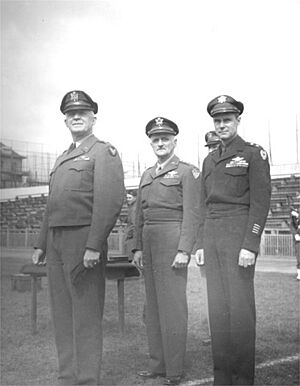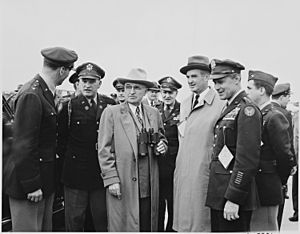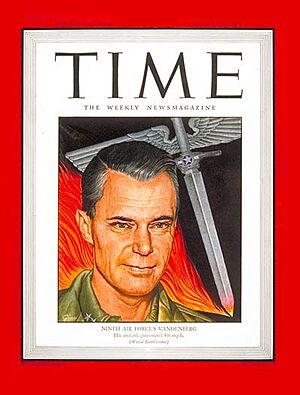Hoyt Vandenberg facts for kids
Quick facts for kids
Hoyt Vandenberg
|
|
|---|---|
 |
|
| Chief of Staff of the Air Force | |
| In office April 30, 1948 – June 29, 1953 |
|
| President | Harry Truman Dwight Eisenhower |
| Deputy | Muir S. Fairchild Nathan F. Twining |
| Preceded by | Carl Spaatz |
| Succeeded by | Nathan Twining |
| Vice Chief of Staff of the Air Force | |
| In office October 1, 1947 – April 30, 1948 |
|
| President | Harry Truman |
| Preceded by | Position established |
| Succeeded by | Muir S. Fairchild |
| 2nd Director of Central Intelligence | |
| In office June 10, 1946 – May 1, 1947 |
|
| President | Harry Truman |
| Deputy | Kingman Douglass Edwin K. Wright |
| Preceded by | Sidney Souers |
| Succeeded by | Roscoe H. Hillenkoetter |
| Personal details | |
| Born |
Hoyt Sanford Vandenberg
January 24, 1899 Milwaukee, Wisconsin, U.S. |
| Died | April 2, 1954 (aged 55) Washington D.C., U.S. |
| Education | United States Military Academy (BA) |
| Military service | |
| Allegiance | United States |
| Branch/service | United States Army United States Air Force |
| Years of service | 1923–1953 |
| Rank | General |
| Commands | Chief of Staff of the United States Air Force Twelfth Air Force Ninth Air Force |
| Battles/wars | World War II Korean War |
| Awards | Army Distinguished Service Medal (3) Silver Star Legion of Merit Distinguished Flying Cross Bronze Star Medal Air Medal (5) |
Hoyt Sanford Vandenberg (born January 24, 1899 – died April 2, 1954) was an important United States Air Force general. He became the second leader of the U.S. Air Force and also served as the second Director of Central Intelligence, which is like the head of the CIA.
During World War II, General Vandenberg led the Ninth Air Force in Europe. This air force helped ground troops in England and France. A special place called Vandenberg Space Force Base in California is named after him. In 1946, he was briefly the U.S. Chief of Military Intelligence. He was also the nephew of Arthur H. Vandenberg, a well-known U.S. Senator.
Contents
Early Life and Education
Hoyt Vandenberg was born in Milwaukee, Wisconsin. His family had Dutch roots. He grew up in Lowell, Massachusetts. As a teenager, he became one of the first Eagle Scouts in his area.
He went to the United States Military Academy at West Point. He graduated in 1923 and joined the United States Army Air Service.
A Career in the Air Force
After West Point, Vandenberg learned to fly. He finished flying school in Texas in 1924. His first job was with the 90th Attack Squadron. He even helped as a stunt pilot for the silent movie "Wings" in 1926. This movie later won the first-ever Academy Award for a film!
He became the commander of the 90th Attack Squadron in 1926. Later, he taught flying at March Field in California. In 1929, he moved to Hawaii to lead the 6th Pursuit Squadron.
Vandenberg continued to learn and grow in the military. He attended special schools like the Air Corps Tactical School and the Command and General Staff School. He became an instructor at the Air Corps Tactical School. He also studied air defense plans for the Philippines.
World War II Service

When the United States entered World War II, Vandenberg quickly rose through the ranks. He became a colonel and helped plan air operations and training. For his excellent work, he received the Distinguished Service Medal.
In 1942, he went to the United Kingdom to help set up the Air Forces in North Africa. He became the chief of staff for the Twelfth Air Force. He also worked with Major General James Doolittle in North Africa. Vandenberg flew on many missions over places like Tunisia and Italy. He earned the Silver Star and the Distinguished Flying Cross for his bravery. He also received the Legion of Merit for his leadership.
In 1944, he was promoted to major general. He then moved to Europe and helped lead the Allied air forces. In August 1944, he took command of the Ninth Air Force. He played a key role in planning the D-Day invasion of Normandy. He was promoted to lieutenant general in 1945.
Post-War Leadership
After the war, Vandenberg became the Director of Intelligence for the War Department. In 1946, he was chosen to be the Director of Central Intelligence, leading the new intelligence agency. He held this important job until 1947.
In 1947, he returned to the Air Force. He became the Vice Chief of Staff of the United States Air Force. When the Air Force became its own separate branch, he was promoted to general.

Even though he was a high-ranking general, people often noticed his youthful looks. He appeared on the covers of Time and Life magazines. He was even called "the most impossibly handsome man" in Washington D.C.
In 1948, General Vandenberg became the Chief of Staff of the United States Air Force. This was the highest position in the Air Force. President Harry S. Truman re-appointed him for a second term. He served until 1953.
During his time as Chief of Staff, he disagreed with a proposed budget cut for the Air Force. He believed the cuts would make the Air Force weaker. The cuts happened shortly after he retired.
Later Life and Legacy

Hoyt Vandenberg loved playing golf. He also enjoyed movies, especially Westerns. He retired from the military in June 1953. He passed away nine months later, in April 1954, at the age of 55, due to cancer. He is buried at Arlington National Cemetery.
His wife, Gladys Vandenberg, started the idea for the Arlington Ladies. This program ensures that a woman from the military service attends all military funerals at Arlington. She is buried next to her husband. They had two children, Gloria and Hoyt S. Vandenberg, Jr..
Places Named After Him
Many places are named in honor of General Vandenberg:
- In 1958, a missile and space base in California was renamed Vandenberg Air Force Base. It is now called Vandenberg Space Force Base.
- In 1963, a ship called the USNS General Hoyt S. Vandenberg (T-AGM-10) was named after him.
- One of the dorms for cadets at the United States Air Force Academy is called Vandenberg Hall.
- A popular spot for Airmen at Keesler AFB in Mississippi is named after him.
- The Vandenberg Esplanade, a park area along the Merrimack River in Lowell, Massachusetts, also honors him.
Images for kids




